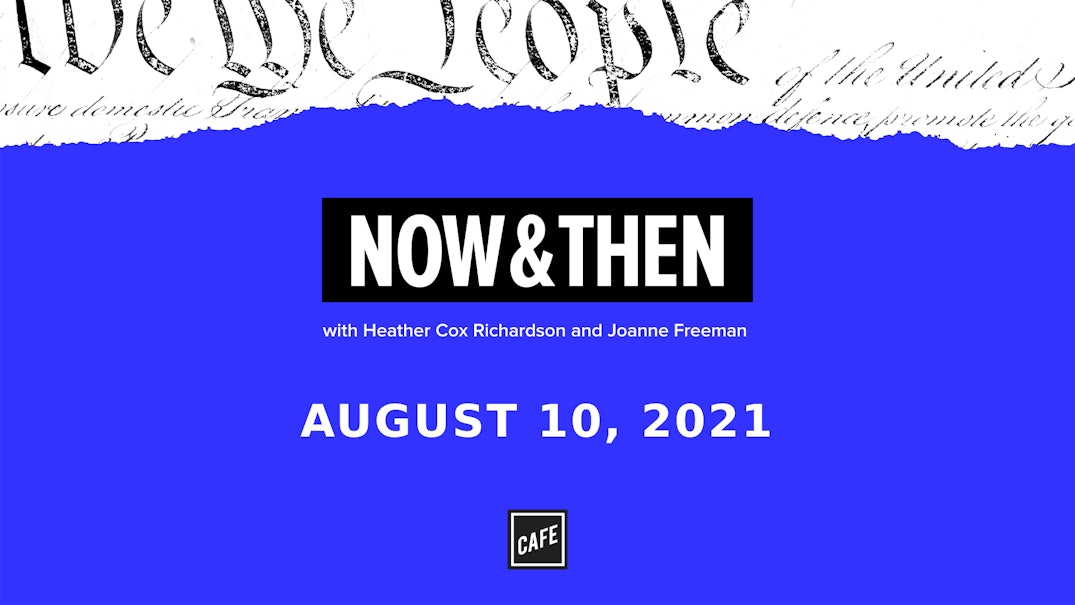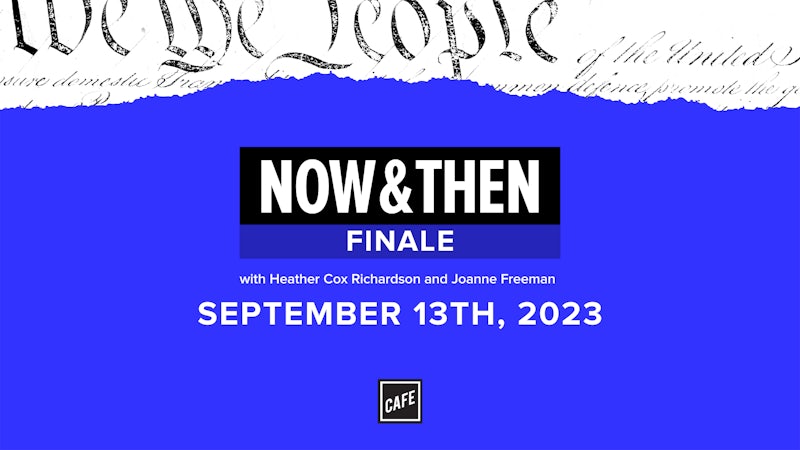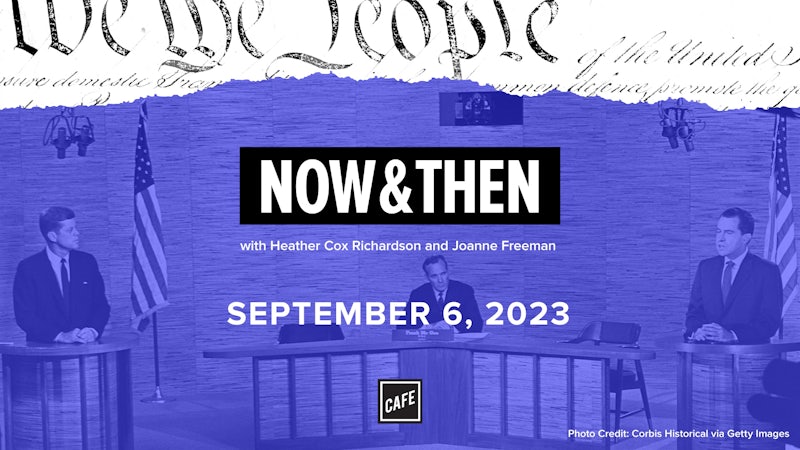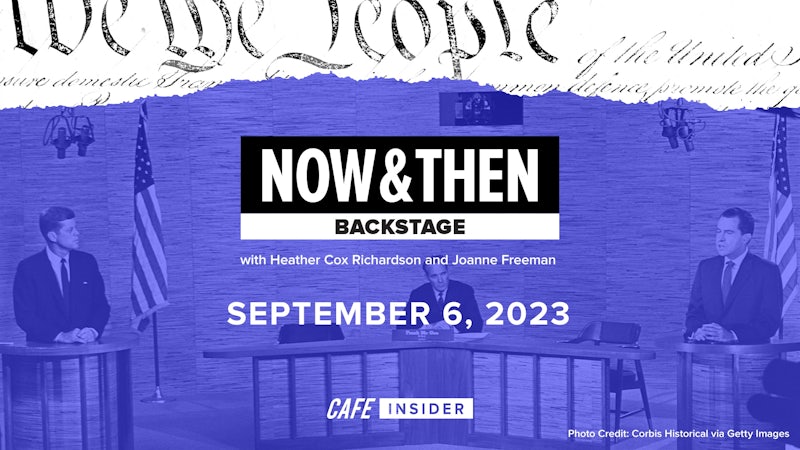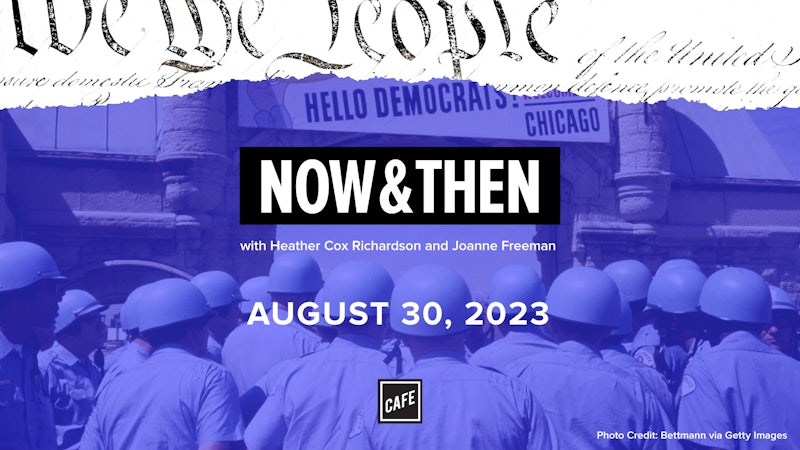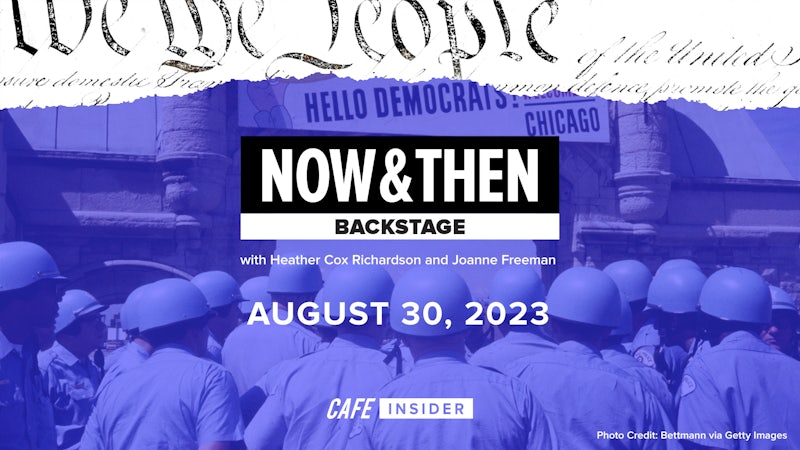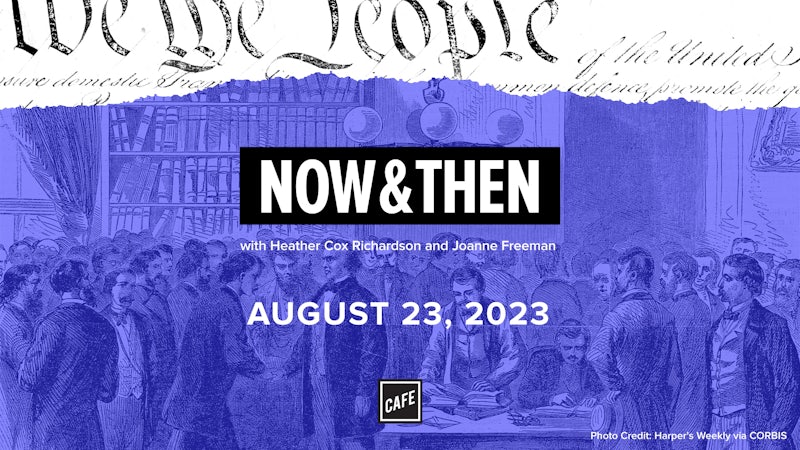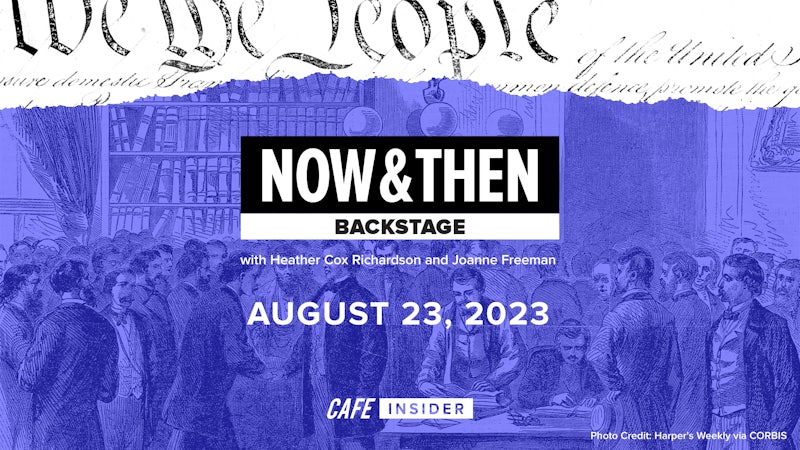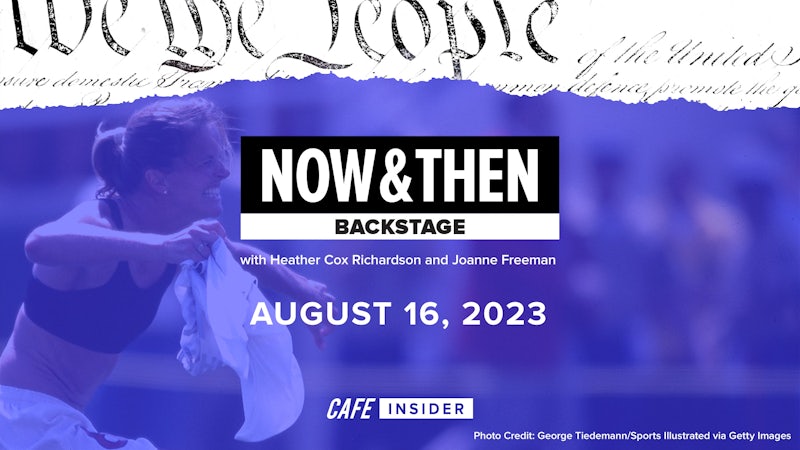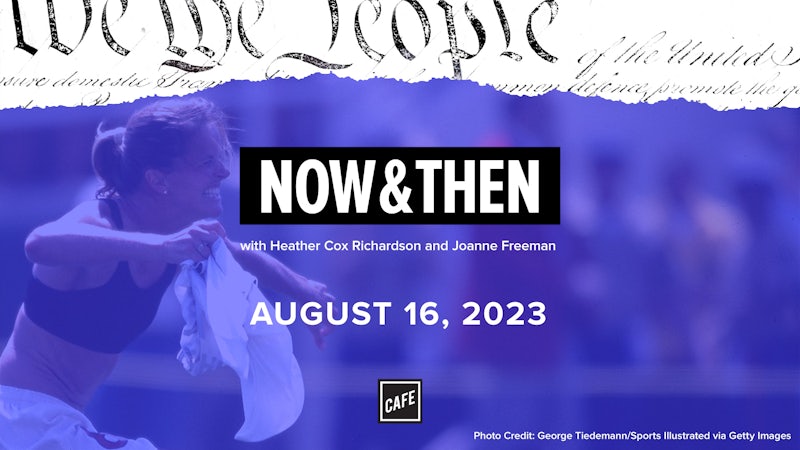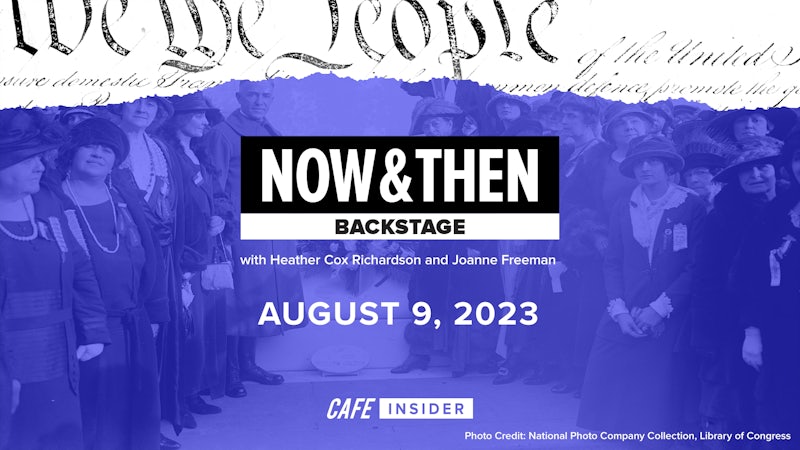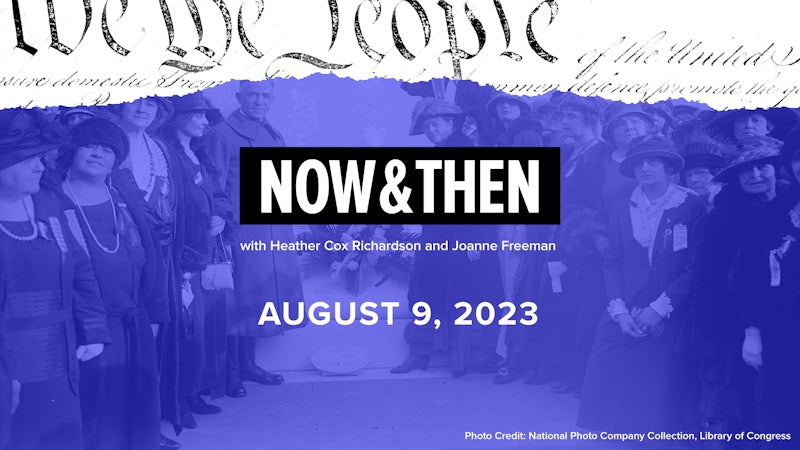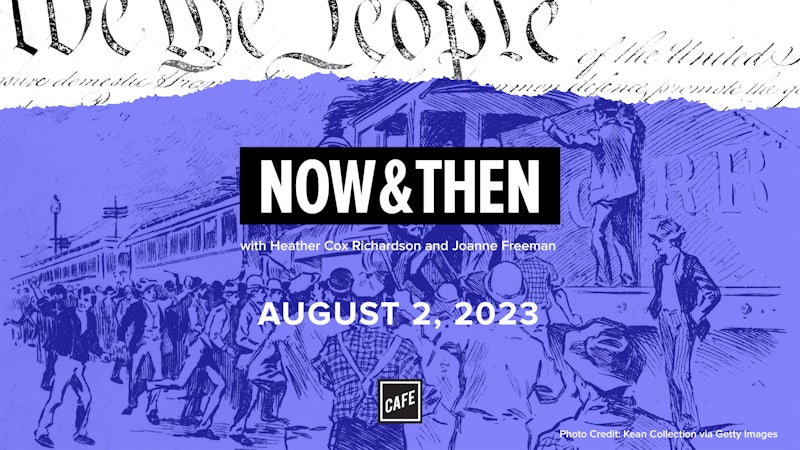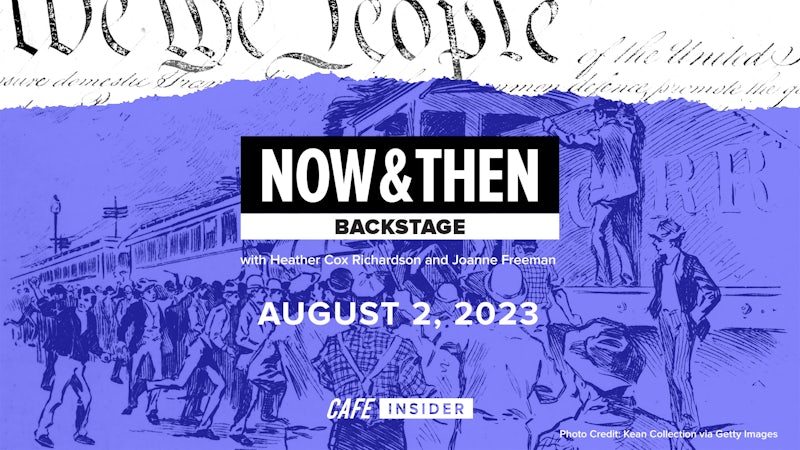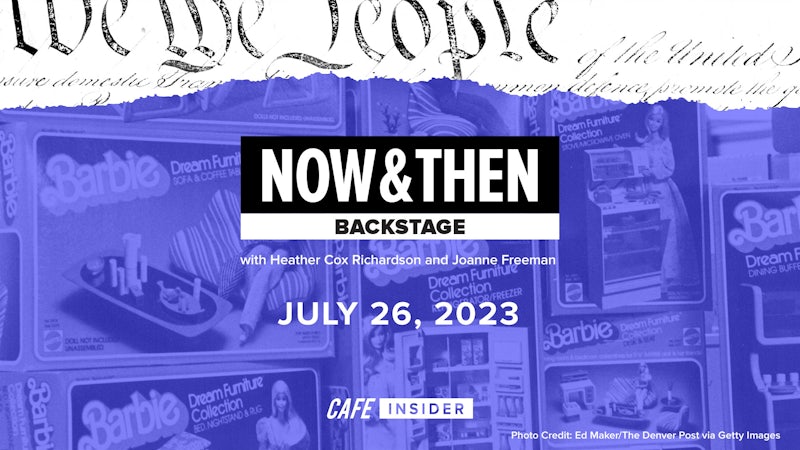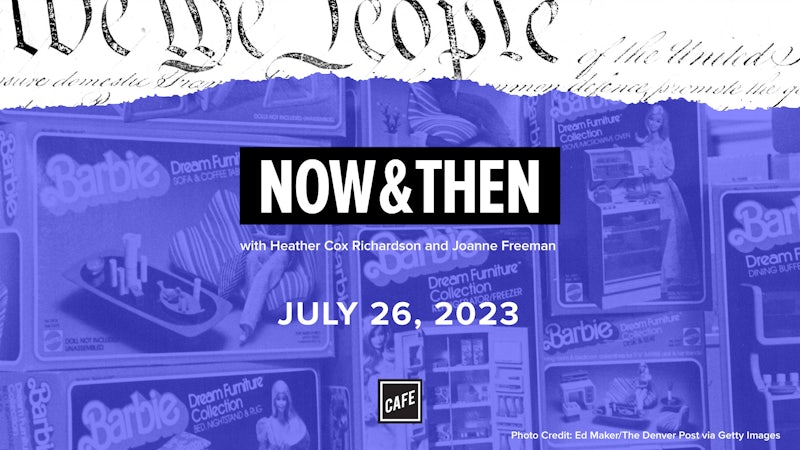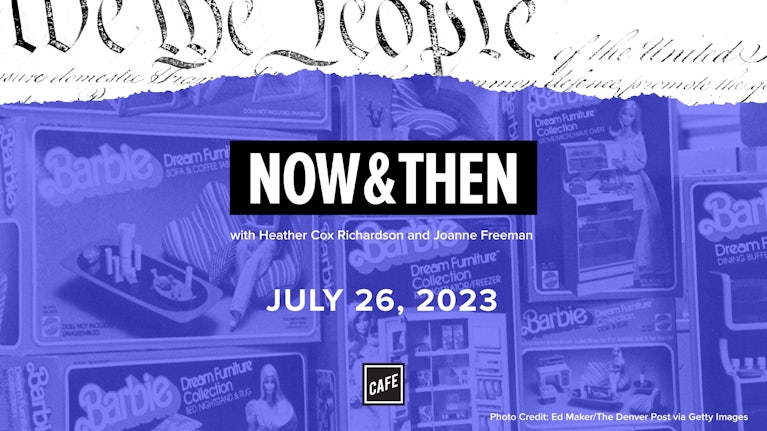Heather Cox Richardson:
From Cafe and the Vox Media Podcast Network, this is Now & Then. I’m Heather Cox Richardson.
Joanne Freeman:
And I’m Joanne Freeman. I’m going to be traveling this week. I will admit I am anxious about it since I have been basically in one room for the last year, but I am going to be traveling, and so we’re going to try something new here on Now & Then. As some of you know, each week Heather and I record a segment of Now & Then called Backstage, which is exclusively for members of Cafe Insider. Backstage gives us a chance to talk about the thought process behind our episodes, what excited us about them, sometimes to reflect on a more personal level about our experiences as historians.
So we really get to sort of toss around ideas and figure things out together after an episode, so normally it’s fun and also really revealing. At least to me, I always find it that way. We’ll have a full new episode of Now & Then for you next Tuesday. In the meantime, we’re going to share two of our favorite segments of Backstage with the wider Now & Then community.
Heather Cox Richardson:
We hope you enjoy these two peeks behind the curtain and sign up for Cafe Insider at Cafe.com\history for full access to Backstage. Last week, Joanne and I talked about the Olympics and other American displays of power on the world stage. For Backstage, we decided to discuss how Disneyland, like the Olympics, formed our perception of American identity. Enjoy it.
Backstage Segment #1: August 3, 2021
Heather Cox Richardson:
So when we started talking about this, Joanne, of course, we were deliberately looking at the ways in which America represented itself on a world stage, and something else came up that we wanted to talk about. And I’m actually really excited about this because I think you and I have very different perspectives on a certain way that America projects itself in the world because of our backgrounds, and that is Disney.
Joanne Freeman:
Now, and I do want to say, when we were like, “What are we going to talk about on Backstage,” both of us pretty quickly were like, “Disneyland.” Talk about image and fairs and popular impact. I mean, Disneyland and Disney pretty much are at the top of the heap.
Heather Cox Richardson:
Well, and we’re probably interesting on this because you have quite a long history with Disneyland, and I went for the first time to Disneyland when I was 56 years old.
Joanne Freeman:
Oh.
Heather Cox Richardson:
I never went as a kid, and so I knew about it only intellectually, and of course what you see on TV, and so I encountered it for the first time a couple of years ago from a really different perspective.
Joanne Freeman:
Now, I’m going to talk in a moment about what I thought as someone younger, but before I do that, I totally have to hear, given that you first encountered it basically where you are now, as a historian with the knowledge you have now, what was your response?
Heather Cox Richardson:
In fairness, I need to probably disclose that my son was an Imagineer there, so that’s why I was there.
Joanne Freeman:
Oh. Okay, yeah, that’s good to disclose.
Heather Cox Richardson:
And so I went with him and with my partner who had also never been before. And my reaction was, first of all, that the old part, the original part, was unbelievably creepy. I know that the whole point of Disneyland was that you could be on a movie set. You were supposed to be part of the set. For example, the characters can never be out of character there. They travel in tunnels under the park because you’re never supposed to see them carrying their pocketbook, and Tinkerbell’s never supposed to have her pocketbook for example, or whatever. But I found that whole construction of a world within a world that was clearly a fantasy even when it was made, just screamed out to me, White Citizens’ Councils.
It really creeped me out, really creeped me out. But then when I got to the newer part, which is designed to have you participate in modern day movies like Cars or Pirates of the Caribbean, I couldn’t help but be incredibly impressed by the sheer quality of the artistry. And I didn’t get the same exclusionary field there. And I will say that the people who were there were from all backgrounds, all countries.
It wasn’t that it was only white people in the old part, but literally, my skin is crawling even thinking about it. But then when you went to the other section, and I have no sense of direction, so I have no idea where it is, I didn’t get that feel at all. All I could think of was, wow, I cannot believe how much work went into creating this experience where you can’t see any of the backstage, if you will.
Joanne Freeman:
It’s the pop culture part that reflects movies. In a sense, it’s the more familiar part as far as what you are looking at. So there’s a lot of messages that do or don’t go along with that material.
Heather Cox Richardson:
Yes. And for me being a writer and recognizing, you see the finished book and nobody recognizes the 4:00 AM morning when you’re like, “Oh my God, where’s that footnote,” you didn’t see that. You didn’t see any of the fact that, for example, if someone drops a scarf even off a ride, the whole thing shuts down because of their safety record. They want to preserve that. So it was this weird kind of 1950s and then present thing, and I really felt it, but maybe that’s because I’d read so much about it. But you grew up going there, right?
Joanne Freeman:
Well, so I have two experiences with Disneyland. Actually, first Disneyland, then Disney World in Florida. Disneyland’s in California. So as a, I don’t know, preteen, maybe teen, my father did market research, was a market researcher, and he was in the movie business. And one way or another, he was doing work with Disney, so I was allowed to go to Disneyland for free whenever I wanted to go to Disneyland, which was, for me at that time and what I thought of Disneyland, magical. I adored Disneyland as a kid.
And the very reason I adored it is just what you said was creepy, Heather, because it was a fantasy, because I could go there and not think about anything except, how many e-tickets do I have left, and where are the chocolate covered frozen bananas? To me, it was not just a fair, because I’ve gone to fairs and Ferris wheels. I’ve been on Ferris wheels. We had the Fireman’s Carnival every summer in Yorktown Heights where I was a kid.
This was different. This was a different world, and that to me was a release of a kind that I don’t think I ever felt anywhere else. I didn’t have to worry about anyone, what anyone thought of me. I think it’s the first time I screamed on a rollercoaster because it was Disneyland and it didn’t matter. So in one way or another, as a kid, the very fact that it was a removed fantasy that just allowed me to let go felt amazing.
And so I wanted to go back again and again and again, for that feeling, not necessarily for one ride, or although I love chocolate covered frozen bananas, not even just for that. It was to have that escapist kind of feeling, which I couldn’t create any other way. Now, being ahead a number of years, and now I’m in grad school and I’m in my 30s, and my partner at the time, he decided for my birthday, he would take me to Disney World.
So I went to Disney World, and I will say, fascinating, when I told some of the faculty there and friends there that I was going to Disney World for my birthday, they were horrified. “Oh my God. Really? The messages that Disney World sends, why would you do that?” And I remember thinking, but can’t I, as a historian, kind of turn that off and just relax and have fun? Well, the answer to that, I found when I went there, which is not so much.
In the Disneyland part of Disney World, I was able to let go and I did enjoy it. And then I went to the EPCOT Center, and the EPCOT Center is really kind of along the lines of what you and I, Heather, were talking about in this episode, which is showing [inaudible] about different nations and has their food. And there’s an American pavilion, which of course, as an American historian, I went to visit. And I mean, I was horrified. I was just horrified.
I wish I could remember the words, but I remember they had great Americans up on the stage speaking. And Will Rogers was up there, and I think he said something wonderful about the American military. And I was in the audience, and I remember turning to my boyfriend, and I was like, “What the hell? What is being said here?” So I ended up kind of being really of split mind. Part of me loved the escapist part, and part of me realized at the EPCOT Center, there was no escape, really, that the present was there, it just depended on whether you paused to notice it or not.
Heather Cox Richardson:
Well, and it’s always creeped me out that… I’ve never been to the Florida one. And as you know, when we were preparing this, I can never remember which is which, but EPCOT stands for Experimental Prototype Community of Tomorrow. Disney really was trying to create this alternative world, and of course there’s any number of layers to that.
Joanne Freeman:
But it’s a different kind of alternative world, right? The regular alternative fantasy world is not real and is not intended to be real. This alternative world is supposedly realistic and what we’re headed towards and who we are. And on that level, suddenly there was no escape from the present.
Heather Cox Richardson:
And one of the things that this brings to mind for me, and we’re talking about Disney, and one of my all-time favorite writers is Bill Pete, who was a Disney illustrator and broke off because of his problems with Disney. He was the main illustrator behind 101 Dalmatians. And I own all of his books, and yes, some of them are problematic, as many are from those days, but he was just such a great writer. But anyway, you think of how deeply Walt Disney and Disney’s constructions have buried themselves in world culture, but certainly American culture and the way Americans think about our culture, and that in a really funny way, I hate to do this, kind of brings me back to Franklin or Jefferson.
Joanne Freeman:
Ooh.
Heather Cox Richardson:
Well, but just think of the idea-
Joanne Freeman:
Wait, I have to applaud the segue, the loop back segue, just the skill of the loop back segue.
Heather Cox Richardson:
Well, but what springs to mind is the fact that one person has had this much control on how Americans see themselves and how the world sees them. And the difference between that, for example, and if you will, even the 1893 World’s Columbian Exposition, where at least there was a committee, or now Simone Biles, who is one person, but she is one person from a very different walk of life than Walt Disney. And it kind of begs the question like, oh God, I hate to do this, but who are we? And how do we present who we are to the world? Who gets to have that say?
Joanne Freeman:
Exactly. And that’s what we’ve been talking about today. And in a way, that’s what smacked me in the face in the EPCOT Center part of Disney World, was suddenly I realized it wasn’t escape. It was making a statement about who we are. It wasn’t even thinking about the future. It was a statement about who we are. And I was horrified at the statement and suddenly felt very much not a part of anything that I was seeing, and suddenly realized, really, the symbolic and representative aspect of it and the power of that, and the ways in which it was woven into the exhibits and the fair, the park as a whole, in ways that it would be very easy, if you’re not a 30-year-old historian sitting in the audience, to overlook.
That right there, that sort of, I love it, it’s fun, and then, oh my God, this does not represent my opinion about very much at all, kind of shows the bind of figuring out what narrative you’re living by or want to live by, discovering the one you’re living by, and then trying to figure out what you can do to create a different one for the future.
Heather Cox Richardson:
I have an idea. Why don’t we start a podcast?
Joanne Freeman:
Hey. I’m in.
Interlude
Heather Cox Richardson:
Back in July, we reflected on the history of federal holidays in light of Juneteenth and the 4th of July. In the next Backstage segment, we talk about the American bicentennial and Joanne’s encounters with some flirtatious historical impersonators.
Joanne Freeman:
Those impersonators, all I can say is harrumph…
Heather Cox Richardson:
And we were hoping to get a harrumph in there, but-
Joanne Freeman:
I know. I haven’t harrumphed in a while.
Backstage Segment #2: July 6th, 2021
Heather Cox Richardson:
One of the things that I really loved about 1976 was the reenactors, because they really, around here, they were reenacting the Declaration of Independence and the Revolutionary War, and they were dressed in the clothing. And I think in a funny way, I had never really realized people dressed differently than… I mean, I knew it intellectually, but seeing these men with their gorgets, for example, or the neck pieces that would protect your neck, or the-
Joanne Freeman:
All the lace.
Heather Cox Richardson:
… lace, and the really heavy clothing that they wore out in July, and the guns. I mean, I actually got to know a number of the reenactors and spent a number of years going to black powder shoots and learning to shoot muskets and [crosstalk]-
Joanne Freeman:
Wait a minute, wait a minute, wait a minute. You can shoot a black powder musket?
Heather Cox Richardson:
Do you know what’s funny? I mean, I haven’t done it in many years now, but yeah, I could load and shoot a black powder… And you know what, which just strikes me as bizarre, I was actually a really good shot. They’re not very-
Joanne Freeman:
I have to add, Heather, I can shoot a black powder dueling pistol, and I was a really good shot as well.
Heather Cox Richardson:
Oh boy. I think we have our next live event. Don’t we?
Joanne Freeman:
I have a little target that was printed out at the police office where they allowed me to train before I shot the pistol, showing-
Heather Cox Richardson:
Wait, wait, wait. Why were you shooting a pistol, a dueling pistol?
Joanne Freeman:
It was a dueling pistol. I was writing about dueling.
Heather Cox Richardson:
Is that how you got tenure? Sorry.
Joanne Freeman:
Give me tenure now. No, I wanted to know what it felt like. I was writing about it. I wanted to see a dueling pistol. I wanted to feel a dueling pistol. I wanted to just have that experience.
Heather Cox Richardson:
So you just went and found somebody with a dueling pistol and said, “Hey, can I learn to do this?”
Joanne Freeman:
I had a friend who was also a historian who knew a police officer who could get us access to a police firing range. And the friend had access to a black powder dueling pistol, and so we arranged this day when we went out to the police firing range and everyone around us was shooting modern guns. And we had this little black powder dueling pistol, which had this very dramatic click kind of noise when you shot it off, which really did not sound like what the other guns sounded like.
Heather Cox Richardson:
Of course it’s not smokeless powder.
Joanne Freeman:
No.
Heather Cox Richardson:
Black powder is smoke powder. That’s one of the things my students are always surprised about when we talk about Gettysburg, for example, is you can’t see anything because they don’t have smokeless powder. But that’s not actually where I wanted to go with this.
Joanne Freeman:
No.
Heather Cox Richardson:
Because I was saying… You know where this is going.
Joanne Freeman:
But you couldn’t resist.
Heather Cox Richardson:
I was saying that because of the reenactors, it’s one of the reasons that we know, for example, that women often died of burns in this period is because when the reenactor of women started putting on the multiple petticoats and stooping over fires, their cotton shifts and petticoats would catch fire. And that’s how we discovered that this was actually a really big problem for women in colonial America, and in early America. I believe Longfellow’s wife died that way. So while I was focusing on the clothing, you had a slightly different experience with reenactors over your career.
Joanne Freeman:
Oh boy.
Heather Cox Richardson:
And I have never had this experience with reenactors, So I thought, perhaps you would like to tell us about it.
Joanne Freeman:
I’m going to speak in generalities because I don’t want to embarrass anyone, but suffice it to say that over the course of my career as a historian, being at any number of reenactments of things, giving keynote addresses or lectures of various sorts, I have certainly seen a lot of reenactors, Thomas Jeffersons and James Madisons, a lot of Alexander Hamiltons, the occasional John Adams. I’ve seen a lot of founder reenactors.
Heather Cox Richardson:
So I have to interrupt here. James Madison was a teeny tiny man. Are the reenactors small who do him? He’s very small.
Joanne Freeman:
I’ve met one James… Well, actually, I have not met one James Madison. I was with a friend who had a drink with a James Madison reenactor, and he was a small man, indeed. So they’re trying. And of course there are a lot of Franklin reenactors. They try. They actually try to find people who are at least in the ballpark of what these original founders, at least in the common American memory, are like. But what happens in particular, I’ve been around a lot of reenactors at events that go on for quite some time, and sometimes that means a documentary film, and sometimes that means a day-long celebration.
Heather Cox Richardson:
Okay. Okay. Let’s cut to the chase here, Joanne.
Joanne Freeman:
I have been flirted with by several founders. I have had founder flirtation happen to me over the years, which I find supremely funny, kind of touching, and supremely funny at the same time. And I do feel, although I can’t believe now I’ve said it actually to a bazillion people, I haven’t ever really talked about it except to my students before, because I’ve always said, “Someone needs to make a documentary on reenactors and who they are and what they do and what they go through to create their characters.” Because they’re really an interesting group of people, because for the most part, they take it very, very seriously.
Heather Cox Richardson:
Yeah. And we learn a lot from them and they bring a lot to life. But I have to ask this, then. Is it weird in the sense that the people that are in your head, the founders, are actually talking to you? The reason I ask that is, I don’t know if you saw on, I guess it was on Twitter recently or on social media, somebody has found a way to take old photographs and make them [crosstalk].
Joanne Freeman:
Oh, I saw that.
Heather Cox Richardson:
And I got to tell you, I completely freaked out at Abraham Lincoln, completely freaked out because it looked real enough that, I mean, it really threw me for a loop. I had nightmares about it that night. Was it weird to have Ben Franklin say, “Hey, sweetie, let’s go get a drink”? [crosstalk] say, right?
Joanne Freeman:
I was going to say, the flirtation was not quite like that. It was a little bit in character, sort of, but the weirdness of it wasn’t so much that they were talking to me, it was that I knew better than most of them knew what they might say. And so a Washington reenactor once came up to me and said something about Hamilton, and I said something back like, “Colonel Hamilton wouldn’t be really excited to hear you say that, because I don’t think he thought… That’s what you thought.” And I think that reenactor did not leave very happy, but the weirdness of it is, and I’ve always thought this when people say-
Heather Cox Richardson:
Okay, that’s weird. That was weird.
Joanne Freeman:
That is weird. It’s weird on so many levels. But people are like, “Wouldn’t you like to meet Hamilton someday?” I don’t know. But the fact of the matter is, if I ever did, who the heck… He wouldn’t want to meet, or what would he think of the person who knows every word he’s written? And he could say something and you could say, “Well, no, actually in 1792, you said this in a letter to that person.” So that would be, I think, for a reenactor or for the real people, kind of a strange and bizarre experience. But yes, Heather, you’ve gotten me to confess this thing.
Heather Cox Richardson:
Now I got to ask. So we know Ben Franklin hit on women constantly. How did one do that in the 1700s?
Joanne Freeman:
The 18th century version of flirtation was just a slightly different version of the same idea. Hamilton in one case got down on his knees in front of a woman at a party and said something about her garter. That’s pretty daring for the 18th century.
Heather Cox Richardson:
Whoa.
Joanne Freeman:
I know. Or there would just be suggestive [crosstalk].
Heather Cox Richardson:
Was he married?
Joanne Freeman:
Yeah. Well, and his wife was there, I think. See, well, the thing about Hamilton flirtation is it’s in its own category, and I’m not going to go into more detail on that. But suffice it to say, I think it was pretty obvious when you were being flirted with, because I think there was a tone of voice, and there was a kind of smile, and there was a knowing nod that probably in one way or another is kind of universal. You look very disbelieving now.
Heather Cox Richardson:
I am speechless, to be honest. I’m trying to imagine, like you said, it’s probably universal. I’m thinking, really? If you dropped a woman back in that era, or a man, would they pick up what was going on? I mean, aside from the weirdness of being dropped 300 years back or wherever we are?
Joanne Freeman:
Well, it depends on the person, I gather. I mean, I’m a pretty low key, mild-mannered person, so I might pick up on some of this stuff. Somebody who’s a lot more aggressive in that realm might not. I don’t know. But at any rate, the larger point here is [crosstalk]-
Heather Cox Richardson:
Yeah, go ahead, dig yourself out of this hole, Joanne. What’s the larger point?
Joanne Freeman:
I am going to dig myself out of the hole, because here’s my segue, and it’s a great segue. Because we did refer during our formal conversation to the bicentennial, and the link to that and these reenactors is… I was thinking about it before this. I was thinking about it before I knew we were going to talk about the bicentennial. I did not know I would be talking about flirting with founders, and that’s a surprise. But the interesting thing about-
Heather Cox Richardson:
That’s totally the name of your biography, by the way, but go ahead.
Joanne Freeman:
Flirting with Founders by Joanne Freeman. I’ll just store that away. You never know when that will appear in an article or something. But in preparation for today, one of the things that I looked at was a TV commercial from the bicentennial for a beer, that suddenly the beer was celebrating the bicentennial. And I was watching it, and it brought back to me for a second the flash of the kind of excitement I had during the bicentennial, which was a very specific kind. I wasn’t hyped up on patriotism. It wasn’t about, ain’t America grand?
What really excited me about the bicentennial was related to what we’re talking about here, which is, it felt real because there was all this stuff going on. There was discussions of all kinds of people and local sites that you could go to that had somehow or other played a role in the revolution and reenactments and all kinds of things, that in one way or another, there was a sort of history is real moment that for me, 12, 13, 14 years old, that was big. That was really exciting to me.
And I don’t think I had thought of it in that way before, and that’s never left me, that sort of excitement at the idea of understanding and getting at aspects of the living past. You can’t recreate it, but if you acknowledge the fact that the past was a human endeavor in one way or another, and people made choices or were prevented from making choices, and that you need to understand that to understand them and their time, that’s a massive insight that can dramatically change how you understand history.
Heather Cox Richardson:
And isn’t it ironic? I’m the exact same here. The idea that there was a revolution in Maine, that people actually read the Declaration of Independence, hence my question to Pauline all those years later, and that people were doing stuff on the coastline, made it all feel like it was all right there under my feet.
Joanne Freeman:
Right. July 4th, 1976. It was like… You and I were speaking about this earlier. We were remembering the tall ships, that everyone was watching the tall ships on TV. I remembered after we spoke that at noon, bells were ringing all around the country. and I remember running outside to hear the bells. It was like, the bicentennial is happening. There was something about it, the at the moment-ness of it, that got me so excited.
Heather Cox Richardson:
Isn’t it extraordinarily ironic that one of the reasons that we got that decentralization that included people like you and me was because Nixon tried to hijack it and make it all about himself?
Joanne Freeman:
I know.
Heather Cox Richardson:
I mean, that’s one of the great things about history, is the contingency that ends up, and there’s your word, but the contingency that ends up, who would have thought that Nixon trying to resurrect his standing in 1968 would have created you and me here all these years later saying, “No, no, this is really what America is about”?
Joanne Freeman:
Right. Right. It’s real people. And there’s a local tie. I mean, I grew up for the most part in Westchester County, and at our local paper, The Reporter Dispatch, for at least a year, if not more, in the back of the front section, there was a sort of bicentennial moment in every newspaper.
Heather Cox Richardson:
Yes. That’s right.
Joanne Freeman:
And I cut them all out and I put them in a scrapbook, and then as often happens with scrapbooks, I didn’t finish pasting them in, so somewhere in the same closet that has bicentennial keychains and fake quill pins from that era, I have a manila envelope full of bicentennial moments from 1976 that have not been pasted anywhere yet. But that was the degree of fascination I had with the whole thing. Like, “Look, real people. It’s really happening.” And that you’ve made fun of me for sitting around reading Hamilton’s letters, goofy 14-year-old that I was, but that’s part of this moment. To me, that was like, it’s real history. It’s the real stuff. It’s what someone wrote, someone actually wrote. It’s not someone telling me about the history. That’s what really grabbed me about the bicentennial.
Heather Cox Richardson:
It brought history to life.
Conclusion
Joanne Freeman:
Right. Well, those impersonators. Harrumph. Anyway, thanks so much for checking out Backstage, and go to Cafe.com history to hear more. We’ll be back next week to talk about the fascinating history of treason and reconciliation in American life. In the meantime, have a wonderful week.
Heather Cox Richardson:
We’ll see you next Tuesday.












